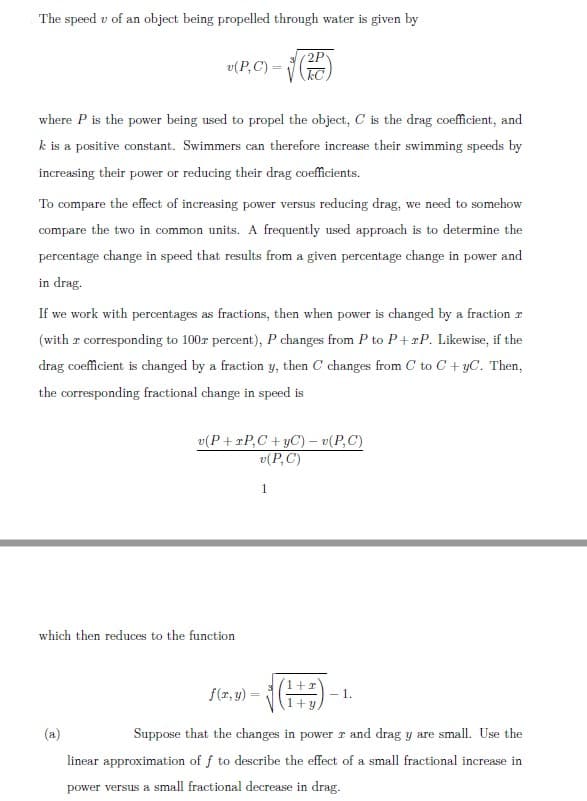The speed v of an object being propelled through water is given by 2P v(P,C) where P is the power being used to propel the object, C is the drag coefficient, and k is a positive constant. Swimmers can therefore increase their swimming speeds by increasing their power or reducing their drag coefficients. To compare the effect of increasing power versus reducing drag, we need to somehow compare the two in common units. A frequently used approach is to determine the percentage change in speed that results from a given percentage change in power and in drag. If we work with percentages as fractions, then when power is changed by a fraction r (with z corresponding to 100r percent), P changes from P to P+ rP. Likewise, if the drag coefficient is changed by a fraction y, then C changes from C to C+ yC. Then, the corresponding fractional change in speed is v(P+ rP,C + yC) – v(P,C) v(P,C) which then reduces to the function f(r, y) (a) Suppose that the changes in power r and drag y are small. Use the linear approximation of f to describe the effect of a small fractional increase in power versus a small fractional decrease in drag.
The speed v of an object being propelled through water is given by 2P v(P,C) where P is the power being used to propel the object, C is the drag coefficient, and k is a positive constant. Swimmers can therefore increase their swimming speeds by increasing their power or reducing their drag coefficients. To compare the effect of increasing power versus reducing drag, we need to somehow compare the two in common units. A frequently used approach is to determine the percentage change in speed that results from a given percentage change in power and in drag. If we work with percentages as fractions, then when power is changed by a fraction r (with z corresponding to 100r percent), P changes from P to P+ rP. Likewise, if the drag coefficient is changed by a fraction y, then C changes from C to C+ yC. Then, the corresponding fractional change in speed is v(P+ rP,C + yC) – v(P,C) v(P,C) which then reduces to the function f(r, y) (a) Suppose that the changes in power r and drag y are small. Use the linear approximation of f to describe the effect of a small fractional increase in power versus a small fractional decrease in drag.
Chapter3: Polynomial Functions
Section3.5: Mathematical Modeling And Variation
Problem 7ECP: The kinetic energy E of an object varies jointly with the object’s mass m and the square of the...
Related questions
Question
PLEASE ANSWER CLEARLY LIKE ASSIGNMENT

Transcribed Image Text:The speed v of an object being propelled through water is given by
2P
v(P,C) =
where P is the power being used to propel the object, C is the drag coefficient, and
k is a positive constant. Swimmers can therefore increase their swimming speeds by
increasing their power or reducing their drag coefficients.
To compare the effect of increasing power versus reducing drag, we need to somehow
compare the two in common units. A frequently used approach is to determine the
percentage change in speed that results from a given percentage change in power and
in drag.
If we work with percentages as fractions, then when power is changed by a fraction r
(with r corresponding to 100z percent), P changes from P to P+xP. Likewise, if the
drag coefficient is changed by a fraction y, then C changes from C to C + yC. Then,
the corresponding fractional change in speed is
v(P + rP,C + yC) - v(P,C)
v(P,C)
1
which then reduces to the function
f(r, y)
1.
(a)
Suppose that the changes in power r and drag y are small. Use the
linear approximation of f to describe the effect of a small fractional increase in
power versus a small fractional decrease in drag.
Expert Solution
This question has been solved!
Explore an expertly crafted, step-by-step solution for a thorough understanding of key concepts.
Step by step
Solved in 3 steps with 3 images

Recommended textbooks for you


Algebra & Trigonometry with Analytic Geometry
Algebra
ISBN:
9781133382119
Author:
Swokowski
Publisher:
Cengage

Algebra for College Students
Algebra
ISBN:
9781285195780
Author:
Jerome E. Kaufmann, Karen L. Schwitters
Publisher:
Cengage Learning


Algebra & Trigonometry with Analytic Geometry
Algebra
ISBN:
9781133382119
Author:
Swokowski
Publisher:
Cengage

Algebra for College Students
Algebra
ISBN:
9781285195780
Author:
Jerome E. Kaufmann, Karen L. Schwitters
Publisher:
Cengage Learning

College Algebra (MindTap Course List)
Algebra
ISBN:
9781305652231
Author:
R. David Gustafson, Jeff Hughes
Publisher:
Cengage Learning

Algebra and Trigonometry (MindTap Course List)
Algebra
ISBN:
9781305071742
Author:
James Stewart, Lothar Redlin, Saleem Watson
Publisher:
Cengage Learning

College Algebra
Algebra
ISBN:
9781305115545
Author:
James Stewart, Lothar Redlin, Saleem Watson
Publisher:
Cengage Learning